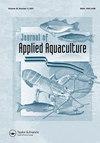Selective breeding of Nile tilapia, Oreochromis niloticus: A strategy for increased genetic diversity and sustainable development of aquaculture in Kenya
IF 0.8
Q3 FISHERIES
引用次数: 5
Abstract
ABSTRACT The aquaculture subsector is important in Kenya for food and nutritional security. The rapid growth of the subsector is evident especially in the widespread culture of Nile tilapia (Oreochromis niloticus); however, the gains made in the industry may be curtailed by inadequate quality seed. Currently, hatcheries are plagued by inbreeding, hybridization of related stocks, and poor-quality broodstock due to lack of proper selective breeding plans or strain improvement for broodstock development. Properly designed selective breeding programs in both public and private hatcheries will be the solution to provision of quality seeds for sustained aquaculture growth. Currently, the fingerlings produced exhibit a low growth rate under culture conditions. This review discusses the significance of genetic improvement of Oreochromis niloticus through selective breeding with reference to current and previous global experiences and reports. Genetic improvement of tilapia is important in provision of quality seeds to farmers for growth in body weight and sustainable aquaculture development. Body weight, survival, and resistance to diseases are heritable traits that can be improved through selective breeding for a long-term genetic gain and trait improvement. A strain improvement program that encompasses establishment of breeding nuclei and programs for monitoring and evaluation of hatcheries, based on the existing standard operating procedures for tilapia seed production, should be in place to ensure adherence to the procedures for stock improvement and sustainable growth of aquaculture in Kenya.尼罗罗非鱼(Oreochromis niloticus)的选择性育种:提高肯尼亚水产养殖遗传多样性和可持续发展的战略
摘要水产养殖在肯尼亚的粮食和营养安全方面具有重要意义。该分部门的快速增长是显而易见的,尤其是在尼罗河罗非鱼(Oreochromis niloticus)的广泛养殖中;然而,该行业的收益可能会因种子质量不足而受到限制。目前,孵化场受到近亲繁殖、相关种群杂交和由于缺乏适当的选择性育种计划或品种改良以培育后代而导致的后代质量差的困扰。公共和私人孵化场设计得当的选择性繁殖计划将是为水产养殖持续增长提供优质种子的解决方案。目前,所生产的鱼种在培养条件下表现出低生长率。本文结合当前和以往的全球经验和报道,讨论了通过选择性育种对尼罗罗非鱼遗传改良的意义。罗非鱼的遗传改良对于向农民提供优质种子以提高体重和可持续水产养殖发展至关重要。体重、存活率和对疾病的抵抗力是可遗传的性状,可以通过选择性育种来提高长期遗传增益和性状改善。应根据罗非鱼种子生产的现有标准操作程序,制定菌株改良计划,包括建立繁殖核心以及孵化场的监测和评估计划,以确保遵守肯尼亚水产养殖的种群改良和可持续增长程序。
本文章由计算机程序翻译,如有差异,请以英文原文为准。
求助全文
约1分钟内获得全文
求助全文
来源期刊

Journal of Applied Aquaculture
Environmental Science-Ecology
CiteScore
3.20
自引率
0.00%
发文量
38
期刊介绍:
The Journal of Applied Aquaculture is a platform for the sharing of practical information needed by researchers to meet the needs of investors, farm managers, extension agents and policy makers working to adapt aquaculture theory to achieve economic and food security objectives in the real world. The journal emphasizes multi-disciplinary research and case studies that propose financially and logistically viable solutions to observable problems.
 求助内容:
求助内容: 应助结果提醒方式:
应助结果提醒方式:


